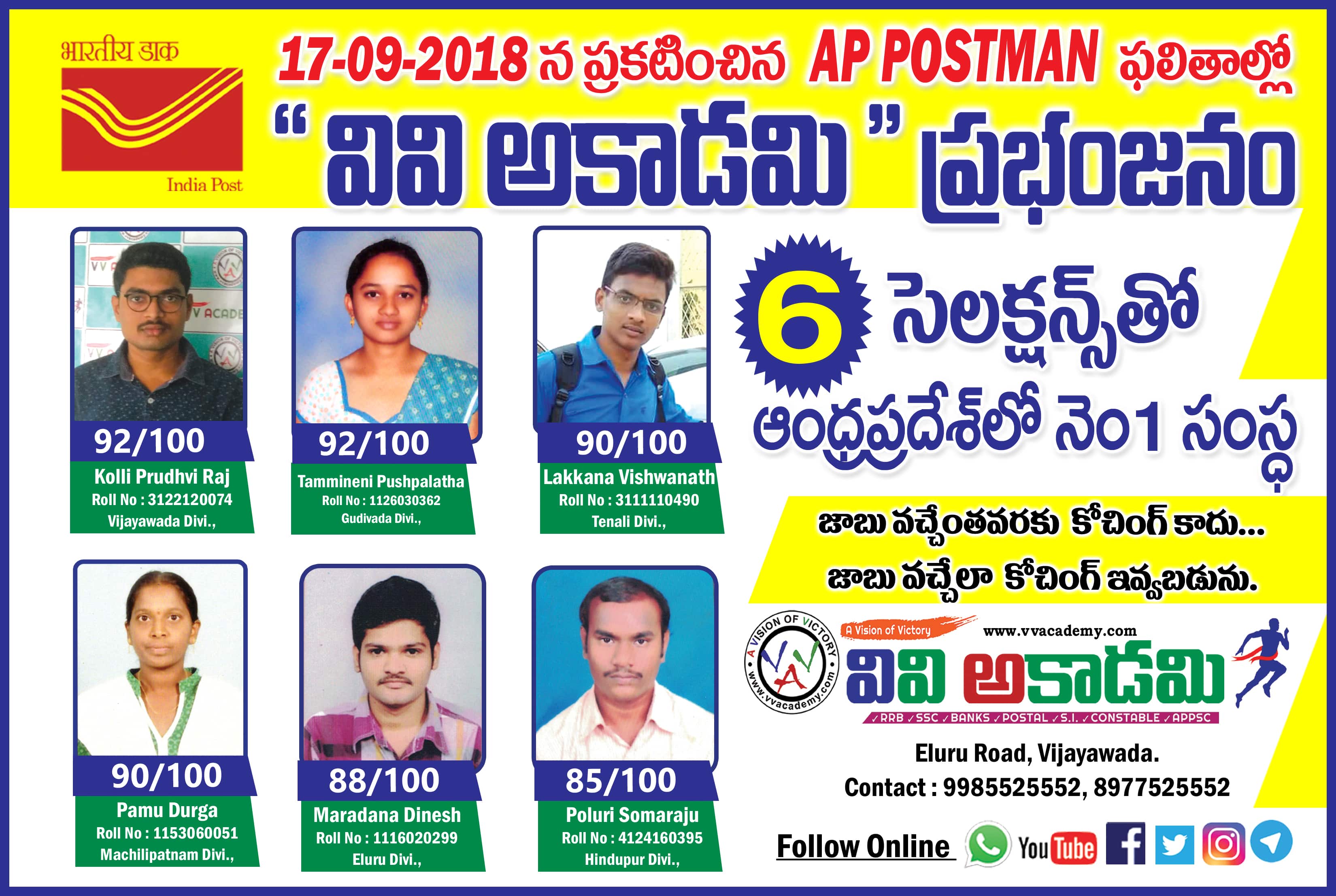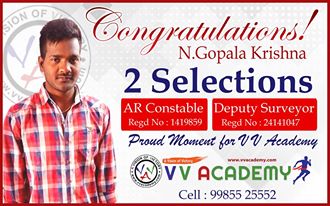[:en][vc_row 0=””][vc_column css=”.vc_custom_1500209282959{border-radius: 10px !important;}”][vc_column_text 0=””]
 V V Academy Vijayawada the Best Coaching for APPSC Group 2 Exams. We Provide APPSC Group 2 Coaching and Coaching for APPSC Group 3 Coaching
V V Academy Vijayawada the Best Coaching for APPSC Group 2 Exams. We Provide APPSC Group 2 Coaching and Coaching for APPSC Group 3 Coaching
APPSC Group 2 Coaching
APPSC GROUP-2 2018 vacancies …Notification Very soon
| 1. | Legislature Secretariat | Legislature Secretariat | Asst., Section Officer | 12 |
| 2. | General Administration Department, A.P Secretariat | GA (SU.II) Dept., | Asst., Section Officer | 150 |
| 3. | A&C Department | Registrar of Coop Societies | Asst., Registrar | 23 |
| 4. | Finance Department, A.P Secretariat | Finance Department | Asst., Section Officer | 15 |
| 5. | Law Department, A.P Secretariat | Law Department | Asst., Section Officer | 2 |
| 6. | PR & RD Department | Commr PR&RD | Extn., Officer | 40 |
| 7. | Revenue Department | CCLA | Dy. Tahsildar | 16 |
| 8. | Commissioner, Endowments | Executive Officer Gr.I | 6 | |
| 9. | MA&UD Department | CDMA | Municipal Commr., Gr.III | 3 |
| 10. | Finance Department | Director of Works and Accounts | Senior Accountants | 20 |
| 11. | Revenue | Commissioner, Prob. & Excise | Excise Sub-Inspectors | 50 |
| Total | 337 |
[/vc_column_text][/vc_column][/vc_row][vc_row][vc_column][vc_column_text]
APPSC Group 2 Exam Selection Process Details:
Andhra Pradesh Public Service Commission (APPSC)’s Group II Examination selection process details are given below…
Selection Procedure: Group II Examination will consists of Written Examination and Interview/ Document verification.
1. Written Examination: The written examination conducted by APPSC is of objective type mode which includes Paper I, II & III.
Paper I consists of General Studies,
Paper II consists of Social and Cultural History of Andhra Pradesh & General overview of the Indian Constitution
Paper III consists of Planning in India and Indian Economy.
Each Paper carries 150 marks and its time duration is 2: 30 hours.
The minimum qualifying marks for candidates is given below…
I. SC/ST/PH Candidates: 135 Marks
II. BC Candidates: 157.5 Marks
III. Others: 180 Marks
Interview/Document Verification:
Only those candidates who qualify in the Written Examination by being ranked high & also based on the rule of reservation will be considered.
The minimum qualifying marks for selection are OCs 40%, BCs 35%, SCs, STs & PHs 30% or as per rules. The minimum qualifying marks are relaxable in the case of SC/ST/BC & PHs on the discretion of the Commission. The candidates will be selected and allotted to Service/ Department as per their rank in the merit list and as per Zonal preference along with he/she must be medically fit for allotment of candidates against the vacancies available. Candidates have to produce Original documents and other particulars for verification as and when required and called for.
The appointment of selected candidates will be subject to their being found medically fit in the appropriate medical classification, and if he is of sound health, active habits free from any bodily defect or infirmity.
[/vc_column_text][/vc_column][/vc_row][vc_row][vc_column width=”1/3″][vc_btn title=”Paper I – General Studies:” color=”pink” align=”center” button_block=”true”][vc_column_text]1. General Science
2. Current Events of National and International Importance.
3. History of India and Indian National Movement. India and World Geography.
4. General Mental Ability.
5. Questions on General Science will cover General appreciation and understanding of science including matters of every day observation and experience, as may be expected of a well educated person who has not made a special study of any particular scientific discipline. In current events, knowledge of significant national and international events will be tested. In History of India, emphasis will be on broad general understanding of the subject in its social, economic and political aspects. Questions on Indian National Movement will relate to the nature and character of the nineteenth century resurgence, growth of Nationalism and attainment of independence. In geography emphasis will be on geography of India. Questions on geography of India will relate to physical, social and economic geography of the country, including the main features of the Indian agricultural and natural resources. On general mental ability, the candidates will be tested on reasoning and analytical abilities.
6. Disaster Management (Source: CBSE Publications)
a. Concepts in disaster management and vulnerability profile of India / State of A.P.
b. Earth quakes / Cyclones / Tsunami / Floods / Drought – causes and effects.
c. Man made disasters – Prevention strategies.
d. Mitigation strategies / Mitigation measures.
[/vc_column_text][vc_separator][vc_column_text] [/vc_column_text][vc_column_text]
[/vc_column_text][vc_column_text] [/vc_column_text][/vc_column][vc_column width=”1/3″][vc_btn title=”Paper II – Social & Cultural History of Andhra Pradesh:” color=”pink” align=”center” button_block=”true”][vc_column_text]1. The Satavahanas and their contribution – social structure – Ikshvakus and their cultural contribution; Buddhism and Jainism; The Eastern Chalukyas of Vengi – their socio-cultural contribution – growth of Telugu language & Literature.
[/vc_column_text][/vc_column][vc_column width=”1/3″][vc_btn title=”Paper II – Social & Cultural History of Andhra Pradesh:” color=”pink” align=”center” button_block=”true”][vc_column_text]1. The Satavahanas and their contribution – social structure – Ikshvakus and their cultural contribution; Buddhism and Jainism; The Eastern Chalukyas of Vengi – their socio-cultural contribution – growth of Telugu language & Literature.
2. Socio- Cultural and Religious conditions in Andhra Desha between first and fifteenth
centuries of the Christian Era.
3. Establishment of British Rule – 1857 Revolt and its impact on Andhra and Hyderabad
Socio-cultural awakening ; Adi-Andhra/Dalit and Justice/self – respect movements; Growth of Nationalist Movement in Andhra between 1885 and 1947 – Role of socialists – communists – anti-zamindari-kisan movements.
4. Asafjahi Dynasty – socio-cultural awakening in Telangana -Adi-Hindu Movement – Nizam Rashtra Janasangham – Andhra Mahasabha – Andhra Saaraswata Parishat – Hyderabad State Congress and Vandemataram Movement.
5. Growth of Leftist / Communist Movement and Telangana People’s Armed Struggle –
Ittehadul-Muslimeen – Razakars-anti-Nizam Struggles and end of Nizam’s Rule. Integration of Hyderabad State into Indian Union – Formation of Andhra Pradesh – Important historical events after 1956.
General Overview of the Indian Constitution:
1. Salient features of the Indian Constitution – Preamble, Fundamental Duties, Fundamental Rights, Directive Principles of State Policy and their relationship.
2. Distinctive features of Indian Federation – Distribution of Legislative Powers between the Union and the State; Relative roles of Legislature, Executive and Judiciary. 17
3. Community development experiment – 3 tier model of Panchayat Raj – 73rd and 74th amendments and their implementation.
4. Welfare Mechanism in India: Provisions for Scheduled Castes, Tribes and Minorities; Reservations for SC, ST and Backward Classes; Prevention of SC and ST Atrocities Act; National and State SC and ST Commission; Women’s Commission; National and States Minorities Commission and Human Rights Commission.
5. Unicameral and Bicameral Legislatures – Functions and crises of accountability, decline of legislature.
[/vc_column_text][/vc_column][vc_column width=”1/3″][vc_btn title=”Paper III – Planning in India & Indian Economy:” color=”pink” align=”center” button_block=”true”][vc_column_text]1. Planning in Indian Economy – Socio-economic objectives and outlays of 5 year plans – Major controversies of planning in India – Alternative strategies – Goals and achievements – shortfall of different plans – Planning in the market – Major reforms/policy changes effect from 1991.
2. Broad fiscal, monetary, industrial trade and agricultural policies, objectives, rationale, constraints and effects.
3. Geographic size – Endowment of natural resources, population; size composition quality and growth trends – occupational distribution – effect of British rule with reference to drain theory and Laissez faire Policy.
4. Money banking and public finances – concept of money and measures of money supply velocity of money banks and credit creation, determination of price level – inflation, its causes and remedies , finance budget – taxes and non-tax revenue.
5. Meaning and measurements of growth- growth distribution and welfare, characteristics of under development, stages of development, sources of growth capital – human capital,
population, productivity, trade and aid, growth strategies – types of average measures – dispersion-correlation-index numbers; types, uses and limitations.
Contemporary Problems and Developments in Rural Society with Special Reference to Andhra Pradesh:
1. National Income & Main sectors of Economy, GDP (Gross Domestic Product), Per capita income and HDI (Human Development Index) as measures of development. Relative contribution of agriculture to income and employment in the recent four decades of AP.
2. Five year plans of AP – Outlays, Finance in public sector plan and resource allocation
pattern in the recent five year plan.
3. Need for and aims of land reforms in AP – Structure of land holdings in AP. Forest, sown and irrigated area in AP. Cropping pattern. Sources of Agricultural finance in AP – Agricultural subsidies.
4. Growth and structure of Industries in Andhra Pradesh , factories, small and tiny sectors, their comparison , growth , weaknesses and problems- Institutional and non-institutional – growth and structure of cooperatives in Andhra Pradesh – Share of cooperatives in total credits – adequacy and problems.
5. Structure of Agricultural outputs – administered prices including support and procurement prices – Public Distribution System in AP ; Service sector of AP – importance, composition and growth with special reference to transport and communication, tourism and information and biotechnology.
[/vc_column_text][/vc_column][/vc_row][:]
![]()

 V V Academy Vijayawada the Best Coaching for APPSC Group 2 Exams. We Provide APPSC Group 2 Coaching and Coaching for APPSC Group 3 Coaching
V V Academy Vijayawada the Best Coaching for APPSC Group 2 Exams. We Provide APPSC Group 2 Coaching and Coaching for APPSC Group 3 Coaching